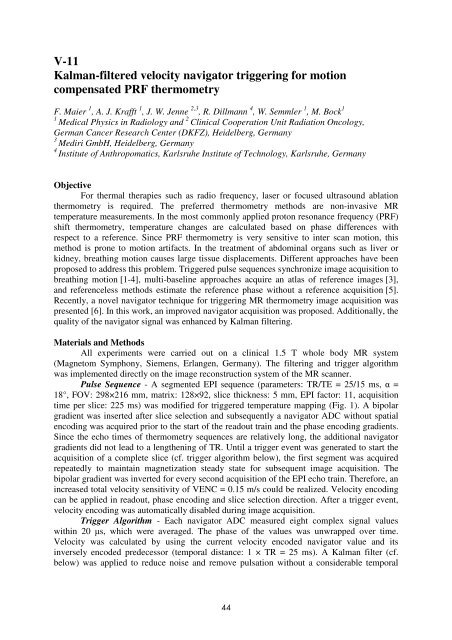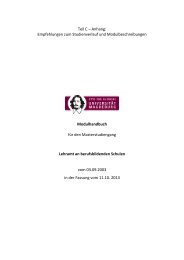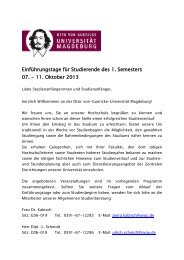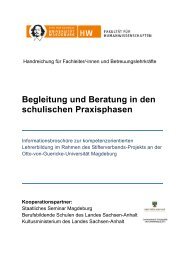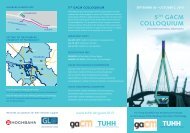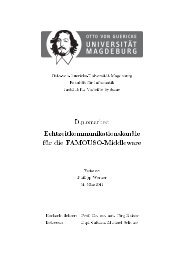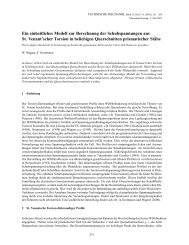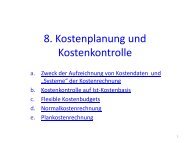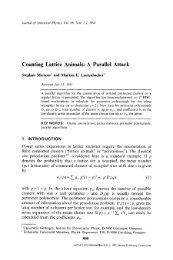8th Interventional MRI Symposium Book of Abstracts - Otto-von ...
8th Interventional MRI Symposium Book of Abstracts - Otto-von ...
8th Interventional MRI Symposium Book of Abstracts - Otto-von ...
You also want an ePaper? Increase the reach of your titles
YUMPU automatically turns print PDFs into web optimized ePapers that Google loves.
V-11<br />
Kalman-filtered velocity navigator triggering for motion<br />
compensated PRF thermometry<br />
F. Maier 1 , A. J. Krafft 1 , J. W. Jenne 2,3 , R. Dillmann 4 , W. Semmler 1 , M. Bock 1<br />
1<br />
Medical Physics in Radiology and 2 Clinical Cooperation Unit Radiation Oncology,<br />
German Cancer Research Center (DKFZ), Heidelberg, Germany<br />
3<br />
Mediri GmbH, Heidelberg, Germany<br />
4<br />
Institute <strong>of</strong> Anthropomatics, Karlsruhe Institute <strong>of</strong> Technology, Karlsruhe, Germany<br />
Objective<br />
For thermal therapies such as radio frequency, laser or focused ultrasound ablation<br />
thermometry is required. The preferred thermometry methods are non-invasive MR<br />
temperature measurements. In the most commonly applied proton resonance frequency (PRF)<br />
shift thermometry, temperature changes are calculated based on phase differences with<br />
respect to a reference. Since PRF thermometry is very sensitive to inter scan motion, this<br />
method is prone to motion artifacts. In the treatment <strong>of</strong> abdominal organs such as liver or<br />
kidney, breathing motion causes large tissue displacements. Different approaches have been<br />
proposed to address this problem. Triggered pulse sequences synchronize image acquisition to<br />
breathing motion [1-4], multi-baseline approaches acquire an atlas <strong>of</strong> reference images [3],<br />
and referenceless methods estimate the reference phase without a reference acquisition [5].<br />
Recently, a novel navigator technique for triggering MR thermometry image acquisition was<br />
presented [6]. In this work, an improved navigator acquisition was proposed. Additionally, the<br />
quality <strong>of</strong> the navigator signal was enhanced by Kalman filtering.<br />
Materials and Methods<br />
All experiments were carried out on a clinical 1.5 T whole body MR system<br />
(Magnetom Symphony, Siemens, Erlangen, Germany). The filtering and trigger algorithm<br />
was implemented directly on the image reconstruction system <strong>of</strong> the MR scanner.<br />
Pulse Sequence - A segmented EPI sequence (parameters: TR/TE = 25/15 ms, =<br />
18°, FOV: 298×216 mm, matrix: 128×92, slice thickness: 5 mm, EPI factor: 11, acquisition<br />
time per slice: 225 ms) was modified for triggered temperature mapping (Fig. 1). A bipolar<br />
gradient was inserted after slice selection and subsequently a navigator ADC without spatial<br />
encoding was acquired prior to the start <strong>of</strong> the readout train and the phase encoding gradients.<br />
Since the echo times <strong>of</strong> thermometry sequences are relatively long, the additional navigator<br />
gradients did not lead to a lengthening <strong>of</strong> TR. Until a trigger event was generated to start the<br />
acquisition <strong>of</strong> a complete slice (cf. trigger algorithm below), the first segment was acquired<br />
repeatedly to maintain magnetization steady state for subsequent image acquisition. The<br />
bipolar gradient was inverted for every second acquisition <strong>of</strong> the EPI echo train. Therefore, an<br />
increased total velocity sensitivity <strong>of</strong> VENC = 0.15 m/s could be realized. Velocity encoding<br />
can be applied in readout, phase encoding and slice selection direction. After a trigger event,<br />
velocity encoding was automatically disabled during image acquisition.<br />
Trigger Algorithm - Each navigator ADC measured eight complex signal values<br />
within 20 s, which were averaged. The phase <strong>of</strong> the values was unwrapped over time.<br />
Velocity was calculated by using the current velocity encoded navigator value and its<br />
inversely encoded predecessor (temporal distance: 1 × TR = 25 ms). A Kalman filter (cf.<br />
below) was applied to reduce noise and remove pulsation without a considerable temporal<br />
44


